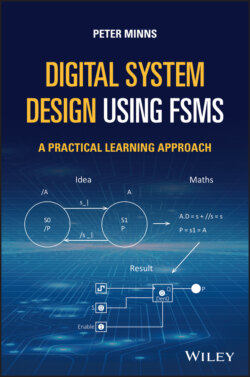Читать книгу Digital System Design using FSMs - Peter D. Minns - Страница 23
Frame 1.9
ОглавлениеThe answer is shown in Figure 1.8.
Figure 1.8 Outside world input between states.
Since in this case the outside world input ‘st’ must be equal to zero (denoted by the inverting bar to the left of the input st (as in /st).
That is / means not so /st means not st, i.e. when st = 0, then /st = 1.
Note that outside world inputs always lie along the transitional lines. Also, the reader could be using ‘·’ as well as ‘*’ for ‘AND’. Also, ‘+’ for ‘OR’ in Boolean equations; however, in most cases ‘.’ will be used rather than ‘*’. In some cases no symbol will be used for ‘AND’, as in ‘AB’ to mean ‘A·B’.
The state diagram must also show how the ‘outside world outputs’ are affected. This is achieved by placing the outside world outputs either:
inside the state circle (or square); or
alongside the state circle (or square).
Figure 1.9 shows the outside world outputs P and Q inside the state circles. In this particular case, P is logic 1 in state s0, and changes to logic 0 when the FSM moves to state s1. Output Q does not change in the above transaction, remaining at logic 0 in both states.
Draw a block diagram showing inputs and outputs for the state diagram.
Then turn to Frame 1.10.
Figure 1.9 Placement of outside world outputs.
